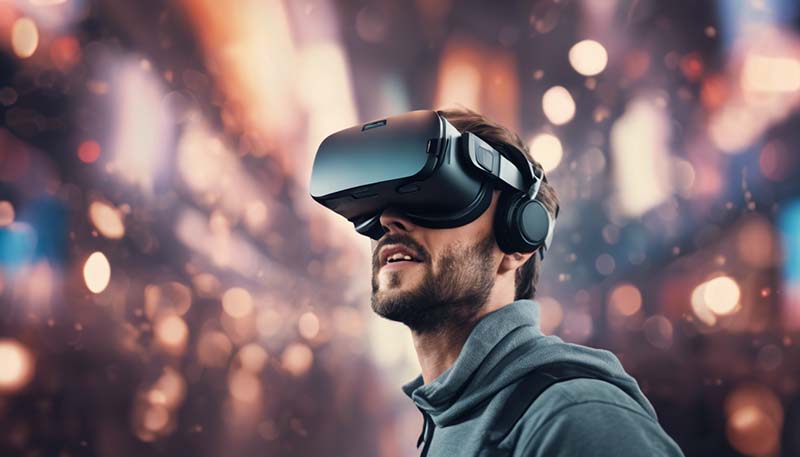The advertising landscape is constantly evolving, with new technologies offering innovative ways to engage consumers. One such technology is virtual reality (VR), which has the potential to revolutionize the way brands connect with their audience. This article explores the intersection of VR and advertising, discussing the current state of VR technology, its applications in advertising, challenges faced, and the potential future of this immersive medium.
## The Current State of Virtual Reality
Virtual reality has come a long way since its inception. Early VR systems were cumbersome and expensive, limiting their use to research and niche markets. However, advancements in technology have made VR more accessible and affordable. Today, there are a variety of headsets available, ranging from simple, smartphone-based devices like Google Cardboard to high-end, tethered systems like the Oculus Rift and HTC Vive.
The increased availability of VR headsets has led to a surge in content creation. Game developers have been at the forefront of VR content, but other industries are quickly catching up. Filmmakers, educational institutions, and real estate agencies are just a few examples of sectors that are exploring the potential of VR.
## Virtual Reality in Advertising
Advertising is a field that is always looking for the next big thing to captivate audiences. VR presents a unique opportunity for advertisers to create immersive, interactive experiences that traditional media cannot match. Here are some ways in which VR is being used in advertising:
Immersive Brand Experiences
One of the most significant advantages of VR is its ability to transport users to entirely new environments. Brands can leverage this to create immersive brand experiences that allow consumers to engage with their products or services in a way that was previously impossible. For example, a car manufacturer could allow users to take a virtual test drive, experiencing the vehicle\'s features and performance in a realistic setting.
Interactive Storytelling
Storytelling is a powerful tool in advertising, and VR takes it to a new level. Interactive narratives allow users to become part of the story, making choices that affect the outcome. This level of engagement can lead to a deeper emotional connection with the brand, as users feel they are actively participating in the brand\'s world.
Product Previews and Demonstrations
VR can be used to showcase products in a way that traditional advertising cannot. Users can explore products in 3D, getting a sense of their size, shape, and functionality. This can be particularly useful for complex products or those that are difficult to convey through 2D images.

Training and Education
Some companies are using VR for training and educational purposes. For instance, a company could create a VR simulation to teach users how to use a new product or service, providing a more engaging and memorable learning experience than traditional manuals or videos.
## Challenges in VR Advertising
While the potential of VR in advertising is vast, there are several challenges that the industry must overcome:
Accessibility
Although VR technology has become more affordable, it is still not universally accessible. Not everyone owns a VR headset, and those who do may not have the technical knowledge to use it effectively. This limits the reach of VR advertising campaigns.
Content Quality
Creating high-quality VR content is a complex and time-consuming process. It requires specialized skills and equipment, which can be costly. This can be a barrier for smaller companies or those with limited budgets.
Motion Sickness
Some users experience motion sickness when using VR, which can limit the duration and types of experiences they are willing to engage with. This is a significant hurdle for advertisers looking to create immersive, long-form VR experiences.
User Privacy
As with any technology that collects user data, there are concerns about privacy and data security. Advertisers must be transparent about how they are using VR data and ensure they are complying with relevant regulations.
## The Future of Virtual Reality in Advertising
Despite the challenges, the future of VR in advertising looks promising. As technology continues to advance, we can expect to see:
Increased Adoption
As VR becomes more mainstream, we can expect to see increased adoption across various sectors. This will lead to greater investment in VR content and technology, driving innovation and making VR advertising more accessible.
Improved Hardware
The next generation of VR headsets is likely to be more comfortable, lightweight, and wireless. This will make them more appealing to a wider audience and could lead to a significant increase in the number of people using VR.
Enhanced Social Experiences
Social VR is an emerging field that allows users to interact with each other in virtual environments. This could lead to new forms of social advertising, where brands can engage with consumers in a more personal and communal way.
Integration with Other Technologies
VR is likely to be integrated with other emerging technologies, such as augmented reality (AR), artificial intelligence (AI), and 5G networks. This will open up new possibilities for advertising, such as real-time, personalized VR experiences that are tailored to each user.
Ethical Considerations
As VR becomes more prevalent in advertising, there will be a need for guidelines and regulations to ensure that it is used ethically. This includes considerations around user consent, data privacy, and the potential for addiction or overuse.
## Conclusion
Virtual reality offers a wealth of opportunities for advertisers looking to create engaging, immersive experiences. While there are challenges to overcome, the potential rewards are significant. As technology continues to evolve and become more accessible, we can expect VR to play an increasingly prominent role in the future of advertising.
Comment